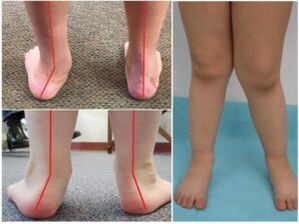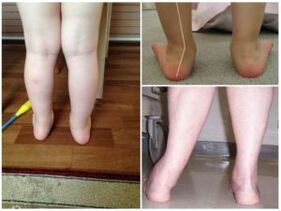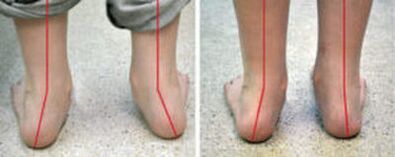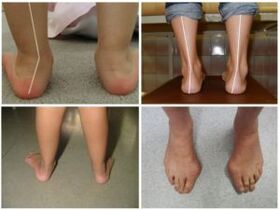Parents must pay great attention to the physical development of their children to adapt the deficiencies in time.The deformation of Valgus del Pieda in children is a frequent pathology.Although the defect is congenital or acquired, the methods of diagnosis, prevention and correction are similar.
What is a Valgus and a flat foot

The term Medici Valgus indicate any curvature of the joints inside the conditional medium line (axis), in which an X -shaped deviation is evident. The most pronounced example of pathology are the thumb bones (Hallux Vallus).Valgus deformation, which is abbreviated as "Valgus Foot" (sun) is the wrong setting of the foot on the horizontal support.If the child has been unable his legs for a year, then the rear is evident while the internal ankle approached the opposite limb and the heel devoted himself outside.At the same time, a flat child is mainly based on the internal (medial) part of the foot.Therefore, the plantar region, so to speak, "seems" outside.A variety of disease is a flat foot (PVS).Combine the flat feet with X -shaped curvature in the child, in addition to the formation of deformation, the set of the foot gradually flattens.
The degree of curvature of Valgus
The stage of abandonment of the pathology is determined by the dimension of the deviation of the heel by the median axis.
There are 4 degrees of illness:
- I - up to 15 °;
- II - 15ches 15 °;
- III - 20ø29 °;
- IV - 30 ° or more.
1-2 Valus deformation stadium can be eliminated with conservative methods.With 3 degrees, prolonged treatment is needed.In 4 phases, surgical correction may be requested.
The causes of deformation
There are three factors, following which there is a curvature of the foot: compromised intrauterine development, chronic physical overload, diseases of the musculoskeletal system.These factors weaken the ligaments, the tendons, the muscles, therefore the foot is not fixed by them in a normal anatomical position.
The reasons of the Valgus acquired, flat valgus foot (code M21.0 in ICD-10):
- Premature setting on the legs, when the child's joints are not yet ready for such loads;
- "Wrong" shoes (close block with a thin high heel, without supinted).
- Muscle hypotension, congenital myodicophy;
- great weight, obesity;
- rickets;
- neuromuscular diseases (polio, cerebral paralysis for children, polyouringopathy of various etiologies);
- congenital dislocation of the thigh and dysplasia of the hip joints;
- trauma to the foot or the lower part of the leg;
- Long -term immobilization of the leg with plaster, tutor or freik cushion.
The congenital origin of the lack of Valgo and the flat valgus of the foot structure (code Q66.6 in the ICD-10) can be due to injuries in the abdomen transferred by a pregnant woman or a genetic disease.This curvature can be seen immediately after birth, sometimes it manifests itself before the child starts walking.
How to determine the deformation of the stop

A change in the lower limb configuration is set along the leg axis.This is the name of the conventional line, visually designed by the center of the hip joint through the knee, to the ankle in the center of the heel.The standard implies the passage of the axis through the center of the joints that should not be moved from it to the right or left.
Characteristics characteristics
In baby children, with the innate nature of Valgus, it is immediately or in the first months of life.Very often, the signs of a defect in the children appear after a year and a half.The presence of the disorder can be suspected by the behavior and pace of the child.Very often, there are the following general symptoms of the pathology:
- greater flexibility of small joints;
- decrease in the height of all the sole;
- The shift of the center of gravity (when trying to walk, the child is based only on the medial side of the foot, his external edge can slightly rise);
- uncertain and mixing pace;
- Fast physical fatigue, the need to rest, to relax the child;
- regular complaints about leg pain, reluctance to walk;
- light swelling and redness of the skin in the foot and ankle;
- Irregular wear of the shoes, more expressed by the internal edge of the sole.
Methodology to identify deformation
The methods of diagnostic defects include an exam with an orthopedist of the child's foot, followed by the direction of the child for instrumental examination.A ray x of the feet is made in three projections to discover the degree of bone movement.They also perform a planetography to determine the height of the ardor and the degree of severity of the flat feet.Using the post -Mo, the pressure center on the sole is calculated.This is an effective diagnostic method, since it allows you to identify Valgus deformations in the early stages.Sometimes, to clarify the results of the exam, an ultrasound of the foot is made.The visual signs of the pathology are the only one, slightly turned and raised in the side direction, the movement of the heel, outdoors from the middle line.With the deformation in the flat valgus, the disappearance of the vault is noted, the flattening of the foot.To exclude the neurological causes of the defect, the orthopedist addresses the child to a small specialist.
Correction methods
To eliminate Valgus, the main tasks are to give the foot of the correct position and the subsequent strengthening of the ligaments attached to the heel and the muscle tendons.
Fixation of the joint in a conservative way
With an innate defect, it is used medications or plaster tutor.The purpose of the rigid setting of the foot in the right corner is to eliminate the curvature by immobilization.Although the ossification is not completed, the tissues are elastic, therefore they are easily susceptible to this correction.With the defect of Valgus acquired, to return the correct setting of the foot, the orthopedic shoes are made to the child.It shouldn't cause discomfort when used.A single special shoe has rigid side supercinators, a soft pillow (Pelot) under the vault of the foot.It is also recommended to wear these shoes during rehabilitation after surgery and to consolidate the results of the treatment.
A variety of sun with one valgus foot
Experts recommend ordering orthoses, shoes or sun for children in orthopedic salons based on the size and foot kicks.The price of the product will be slightly higher, but the use will give a more evident result.
Strengthen small joints

For the general hardships and toned tonic of the lower ends, it is recommended to use the contrasting bathroom.For this, the feet are immersed alternately in a container with cold and hot water.They start with a temperature of 36 ° C with a liquid, so this value is changed every week of 1 ° C. gradually leading to an interval from 14 to 40 ° C.
It is useful to do the following exercises:
- Alternative walking on socks, heels, internal edges, exterior of the sole;
- Collect small objects, tighten fabric or paper, draw with your fingers;
- Stay the sole on the ball on the floor;
- a series of exercises for the fingers (extinct, reproduction and closing of the flexion);
- Walk on pebbles and an irregular surface.
The orthopedist can prescribe a lumbar column massage course, influenced by the lower limb or by both legs.It is optimal to perform it after heating with the paraffin or ozakeric application.The muscles of the internal surface of the legs are acted by toned massage movements (deficiency, dough).The external surface of the legs should be massaged with relaxing techniques: caressing, rubbing.
Physiotherapy procedures
If the deformation of the foot has caused the inflammation of the joint structures, the tendons of the muscles, the child is prescribed electrophoresis with painkillers and anti -inflammatory drugs, magnetotherapy, black wax application, paraffin and therapeutic mud.For selective muscle stimulation, diadinnamic currents are used.
Surgical treatment
In early childhood, radical therapy methods are not used.But if the defect interferes with normal walk, the operation is performed to small children.During surgery, doctors who use metal elements (titanium wire, screws, plates) fix the deformed joint in a normal position.Surgeons can also strengthen the joint by moving the fibula tendon or lengthening the Achille tendon.After these operations, rehabilitation includes the use of orthopedic products, massage, physiotherapy and physiotherapy exercises.
Preventive measures
To avoid the deformation of Valgus del Pieda, it is necessary to buy a comfortable child shoes corresponding to the size of the leg, the anatomical structure of the foot.How to choose - Look at the advice of E.O.Komarovsky at the video.The doctor affirms the disease that it is a frequent violation in children and help to form the foot to form correctly to form until the age of 12.The teenager most likely needs an operation to correct the pronounced defect of the foot.The child should walk barefoot on sand, grass, walk a lot, eat completely.The dosed sun prevents the rachions in children, which is one of the causes of the disease.Physical education, hardening of the body, regular general strengthening massage courses.Gymnastics for foot muscles is also important, including the creation of a reason for one leg in the sand.Active external games, swimming also contributes to the strengthening of the muscles and ligaments of the lower limbs.All these measures prevent the development of foot defects.It is forbidden to put the child's legs up to 7.5 grams .8 months, when the joints and bones of the lower ends have not yet been strengthened.It is unacceptable to lose the planned pediatrician exams and restricted specialists, which allow to identify the pathology in an initial phase.
Medical answers to parents' questions
How to warn the congenital deformation of the Valgo?Unfortunately, the vice of the development of the musculoskeletal system cannot be prevented.Even if they have not found deviations in the hospital, the child should be regularly inspected by a pediatrician, receive massage, walk barefoot on an irregular, but safe surface for the legs.At home, it is recommended to use a massage carpet.The acquisition of high quality shoes also helps to put the foot in the correct position, to form a series of physiological heights.This prevention will stop the progression of the congenital valgus foot.
Which doctor treats the pathology?
If necessary, the pediatrician directs the child to the children's orthopedist, the traumatologist, the surgeon.
What is a varied foot?
Varus deviations are the movement of the heel bone inside the midline.In this case, the set of the foot is made very high and the pressure center is moved to the outer edge of the sole.A defect is treated with the same methods as Valgus deformation, only the deviation angle is regulated on the opposite side of the foot.
Valgus Deformation of the Foot in children: consequences and correction
The deformation of Valgus del Pieda is a pathological change in the musculoskeletal system, in which the height of the set of foot and the axis of the lower limbs is reduced.
The defect can be congenital or develop during childhood, bringing dishes, violation of posture and other health problems on foot.As a rule, it is conservatively adequate, during the long therapy with charge, massages, physiotherapy.With regular work on the deformation, it is possible to obtain an adequate setting of the leg and safe outlay.
Deformation to the Flat Foot Valgus in children-slutomas
This defect in the legs can be recognized by the following external signs:
- The foot is scattered with the internal rib, the child rests on the inside of the foot;
- The heel and fingers are lined up to the outside;
- The central part of the foot is flat or significantly reduced;
- When the knees are reduced, the legs acquire an IX-BROW shape, the legs do not converge together, between them remains the distance of about 4-5 cm;
- Canda uncertain, clumsy, the child often blocked, mixes;
- The child gets tired quickly during a walk.

When can a defect occur?
The arch of the foot begins to form from the moment the child tries to take his first steps.For children, a flat foot is considered the norm.When they take on a vertical position independently, children develop a musculoskeletal system, "accustomed" to new functions.Bones and ligaments begin to experiment with loads, the foot is strengthened and takes the correct anatomical form.This usually happens up to 1.5 years.If at this age the times remain flat, there is no formal fold, the doctors define it as a Valgus of the foot deformation.As a rule, violations are detected in medical tests, but if the parents have noticed the above signs independently, it is necessary to immediately contact an orthopedist.If you start the adaptation as soon as possible, the restoration is faster and without serious consequences.
Conclusion
Parents must devote the maximum time to the prevention of defects in the physical development of the child, including gymnastics, massage courses and other recreational activities.If the valgus foot deformation in children is not eliminated from conservative treatment, it is necessary to accept surgery to correct the shape of the foot.After all, the advanced pathology is striking of the development of arthrosis, diseases of the spine and the shortage of the limb.
























